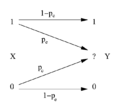Definition
A process  with a countable index gives rise to the sequence of its joint entropies
with a countable index gives rise to the sequence of its joint entropies  . If the limit exists, the entropy rate is defined as
. If the limit exists, the entropy rate is defined as

Note that given any sequence  with
with  and letting
and letting  , by telescoping one has
, by telescoping one has  . The entropy rate thus computes the mean of the first
. The entropy rate thus computes the mean of the first  such entropy changes, with
such entropy changes, with  going to infinity. The
going to infinity. The  th entropy change is itself the conditional entropy
th entropy change is itself the conditional entropy  . The entropy rate is thus the average entropy of the distribution of the
. The entropy rate is thus the average entropy of the distribution of the  th variable once the previous ones are known. The behaviour of joint entropies from one index to the next is also explicitly subject in some characterizations of entropy.
th variable once the previous ones are known. The behaviour of joint entropies from one index to the next is also explicitly subject in some characterizations of entropy.
Discussion
While  may be understood as a sequence of random variables, the entropy rate
may be understood as a sequence of random variables, the entropy rate  represents the average entropy change per one random variable, in the long term.
represents the average entropy change per one random variable, in the long term.
It can be thought of as a general property of stochastic sources - this is the subject of the asymptotic equipartition property.
For strongly stationary processes
A stochastic process also gives rise to a sequence of conditional entropies, comprising more and more random variables. For strongly stationary stochastic processes, the entropy rate equals the limit of that sequence

The quantity given by the limit on the right is also denoted  , which is motivated to the extent that here this is then again a rate associated with the process, in the above sense.
, which is motivated to the extent that here this is then again a rate associated with the process, in the above sense.
For Markov chains
Since a stochastic process defined by a Markov chain that is irreducible and aperiodic has a stationary distribution, the entropy rate is independent of the initial distribution [1] .
For example, consider a Markov chain defined on a countable number of states. Given its right stochastic transition matrix  and an entropy
and an entropy

associated with each state, one finds

where  is the asymptotic distribution of the chain.
is the asymptotic distribution of the chain.
In particular, it follows that the entropy rate of an i.i.d. stochastic process is the same as the entropy of any individual member in the process.
This page is based on this
Wikipedia article Text is available under the
CC BY-SA 4.0 license; additional terms may apply.
Images, videos and audio are available under their respective licenses.




















